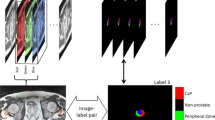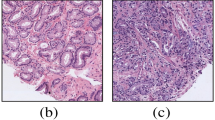Abstract
Identifying indolent and aggressive prostate cancers is a critical problem for optimal treatment. The existing approaches of prostate cancer detection are facing challenges as the techniques rely on ground truth labels with limited accuracy, and histological similarity, and do not consider the disease pathology characteristics, and indefinite differences in appearance between the cancerous and healthy tissue lead to many false positive and false negative interpretations. Hence, this research introduces a comprehensive framework designed to achieve accurate identification and localization of prostate cancers, irrespective of their aggressiveness. This is accomplished through the utilization of a sophisticated multilevel bidirectional long short-term memory (Bi-LSTM) model. The pre-processed images are subjected to multilevel feature map-based U-Net segmentation, bolstered by ResNet-101 and a channel-based attention module that improves the performance. Subsequently, segmented images undergo feature extraction, encompassing various feature types, including statistical features, a global hybrid-based feature map, and a ResNet-101 feature map that enhances the detection accuracy. The extracted features are fed to the multilevel Bi-LSTM model, further optimized through channel and spatial attention mechanisms that offer the effective localization and recognition of complex structures of cancer. Further, the framework represents a promising approach for enhancing the diagnosis and localization of prostate cancers, encompassing both indolent and aggressive cases. Rigorous testing on a distinct dataset demonstrates the model’s effectiveness, with performance evaluated through key metrics which are reported as 96.72%, 96.17%, and 96.17% for accuracy, sensitivity, and specificity respectively utilizing the dataset 1. For dataset 2, the model achieves the accuracy, sensitivity, and specificity values of 94.41%, 93.10%, and 94.96% respectively. These results surpass the efficiency of alternative methods.










Similar content being viewed by others
Data Availability
The dataset used in this study is available publicly.
References
Feng, Yujie, Fan Yang, Xichuan Zhou, Yanli Guo, Fang Tang, Fengbo Ren, Jishun Guo, and Shuiwang Ji. “A deep learning approach for targeted contrast-enhanced ultrasound-based prostate cancer detection.” IEEE/ACM Transactions on Computational Biology and Bioinformatics 16, no. 6 (2018): 1794-1801.
Iqbal, Saqib, Ghazanfar Farooq Siddiqui, Amjad Rehman, Lal Hussain, Tanzila Saba, Usman Tariq, and Adeel Ahmed Abbasi. “Prostate cancer detection using deep learning and traditional techniques.” IEEE Access 9 (2021): 27085–27100.
Arif, Muhammad, Ivo G. Schoots, Jose Castillo Tovar, Chris H. Bangma, Gabriel P. Krestin, Monique J. Roobol, WiroNiessen, and Jifke F. Veenland. “Clinically significant prostate cancer detection and segmentation in low-risk patients using a convolutional neural network on multi-parametric MRI.” European Radiology 30 (2020): 6582–6592.
Abbasi, Adeel Ahmed, Lal Hussain, Imtiaz Ahmed Awan, Imran Abbasi, Abdul Majid, Malik Sajjad Ahmed Nadeem, and Quratul-Ain Chaudhary. “Detecting prostate cancer using deep learning convolution neural network with transfer learning approach.” Cognitive Neurodynamics 14 (2020): 523–533.
Chen, Yingna, Chengdang Xu, Zhaoyu Zhang, Anqi Zhu, Xixi Xu, Jing Pan, Ying Liu, Denglong Wu, Shengsong Huang, and Qian Cheng. “Prostate cancer identification via photoacoustic spectroscopy and machine learning.” Photoacoustics 23 (2021): 100280.
Bhattacharya, Indrani, Arun Seetharaman, Christian Kunder, Wei Shao, Leo C. Chen, Simon JC Soerensen, Jeffrey B. Wang et al. “Selective identification and localization of indolent and aggressive prostate cancers via CorrSigNIA: an MRI-pathology correlation and deep learning framework.” Medical Image Analysis 75 (2022): 102288.
de Vente, Coen, Pieter Vos, MatinHosseinzadeh, JosienPluim, and MitkoVeta. “Deep learning regression for prostate cancer detection and grading in bi-parametric MRI.” IEEE Transactions on Biomedical Engineering 68, no. 2 (2020): 374–383.
Broomfield, Joseph, MelpomeniKalofonou, Sylvia Franklin, Sue M. Powell, Thomas Pataillot-Meakin, Nicolas Moser, Charlotte L. Bevan, and Pantelis Georgiou. “Handheld ISFET Lab-on-Chip detection of TMPRSS2-ERG and AR mRNA for prostate cancer prognostics.” IEEE Sensors Letters (2023).
Prostate158 - Training data https://zenodo.org/record/6481141#.Y2TN73ZBy3A accessed on October 2023.
Prostate MRI dataset https://www.medicaldata.cloud/data-sets/prostate-mri-dataset/ accessed on October 2023.
Seetharaman, Arun, Indrani Bhattacharya, Leo C. Chen, Christian A. Kunder, Wei Shao, Simon JC Soerensen, Jeffrey B. Wang et al. “Automated detection of aggressive and indolent prostate cancer on magnetic resonance imaging.” Medical Physics 48, no. 6 (2021): 2960–2972.
Garcia‐Marques, Fernando, Shiqin Liu, Sarah M. Totten, Abel Bermudez, Cheylene Tanimoto, En‐Chi Hsu, Rosalie Nolley et al. “Protein signatures to distinguish aggressive from indolent prostate cancer.” The Prostate 82, no. 5 (2022): 605–616.
Duan, Heying, and Andrei Iagaru. “The use of advanced imaging in guiding the further investigation and treatment of primary prostate cancer.” Cancer Imaging 22, no. 1 (2022): 1-12.
Hennigan, S. Thomas, Shana Y. Trostel, Nicholas T. Terrigino, Olga S. Voznesensky, Rachel J. Schaefer, Nichelle C. Whitlock, Scott Wilkinson et al. “Low abundance of circulating tumor DNA in localized prostate cancer.” JCO precision oncology 3 (2019): 1–13.
Cheng, Pi-Wan, Samuel Davidson, and Ganapati Bhat. “Markers of malignant prostate cancer cells: Golgi localization of α-mannosidase 1A at GM130-GRASP65 site and appearance of high mannose N-glycans on cell surface.” Biochemical and biophysical research communications 527, no. 2 (2020): 406-410.
Eickelschulte, Samaneh, Anja Lisa Riediger, Arlou Kristina Angeles, Florian Janke, Stefan Duensing, Holger Sültmann, and Magdalena Görtz. “Biomarkers for the Detection and Risk Stratification of Aggressive Prostate Cancer.” Cancers 14, no. 24 (2022): 6094.
Dillinger, T., Sheibani-Tezerji, R., Pulverer, W., Stelzer, I., Hassler, M.R., Scheibelreiter, J., Pérez Malla, C.U., Kuroll, M., Domazet, S., Redl, E. and Ely, S., 2022. Identification of tumor tissue-derived DNA methylation biomarkers for the detection and therapy response evaluation of metastatic castration resistant prostate cancer in liquid biopsies. Molecular Cancer, 21(1), pp.1-8.
Moroianu, Ştefania L., Indrani Bhattacharya, Arun Seetharaman, Wei Shao, Christian A. Kunder, Avishkar Sharma, Pejman Ghanouni, Richard E. Fan, Geoffrey A. Sonn, and Mirabela Rusu. “Computational Detection of Extraprostatic Extension of Prostate Cancer on Multiparametric MRI Using Deep Learning.” Cancers 14, no. 12 (2022): 2821.
Rangel-Pozzo, Aline, Songyan Liu, Gabriel Wajnberg, Xuemei Wang, Rodney J. Ouellette, Geoffrey G. Hicks, Darrel Drachenberg, and Sabine Mai. “Genomic analysis of localized high-risk prostate cancer circulating tumor cells at the single-cell level.” Cells 9, no. 8 (2020): 1863.
Bhattacharya, Indrani, David S. Lim, Han Lin Aung, Xingchen Liu, Arun Seetharaman, Christian A. Kunder, Wei Shao et al. “Bridging the gap between prostate radiology and pathology through machine learning.” Medical Physics 49, no. 8 (2022): 5160–5181.
Cuocolo, Renato, Maria Brunella Cipullo, Arnaldo Stanzione, Lorenzo Ugga, Valeria Romeo, Leonardo Radice, Arturo Brunetti, and Massimo Imbriaco. “Machine learning applications in prostate cancer magnetic resonance imaging.” European radiology experimental 3, no. 1 (2019): 1–8.
Zhu, Lina, Ge Gao, Yi Zhu, Chao Han, Xiang Liu, Derun Li, Weipeng Liu et al. “Fully automated detection and localization of clinically significant prostate cancer on MR images using a cascaded convolutional neural network.” Frontiers in Oncology 12 (2022): 958065.
Jones, Abby L., Lasangi Dhanapala, Thaísa A. Baldo, Mohamed Sharafeldin, Colleen E. Krause, Min Shen, Shirin Moghaddam et al. “Prostate cancer diagnosis in the clinic using an 8-protein biomarker panel.” Analytical Chemistry 93, no. 2 (2020): 1059–1067.
Toth, Reka, Heiko Schiffmann, Claudia Hube-Magg, Franziska Büscheck, Doris Höflmayer, Sören Weidemann, Patrick Lebok et al. “Random forest-based modelling to detect biomarkers for prostate cancer progression.” Clinical epigenetics 11 (2019): 1–15.
Mohammed, Siham A., Sadeq Darrab, Salah A. Noaman, and Gunter Saake. “Analysis of breast cancer detection using different machine learning techniques.” In Data Mining and Big Data: 5th International Conference, DMBD 2020, Belgrade, Serbia, July 14–20, 2020, Proceedings 5, pp. 108–117. Springer Singapore, 2020.
Barata, Catarina, Jorge S. Marques, and M. Emre Celebi. “Deep attention model for the hierarchical diagnosis of skin lesions.” In Proceedings of the IEEE/CVF Conference on Computer Vision and Pattern Recognition Workshops, pp. 0–0. 2019.
Gao, Riqiang, Yuankai Huo, Shunxing Bao, Yucheng Tang, Sanja L. Antic, Emily S. Epstein, Aneri B. Balar et al. “Distanced LSTM: time-distanced gates in long short-term memory models for lung cancer detection.” In Machine Learning in Medical Imaging: 10th International Workshop, MLMI 2019, Held in Conjunction with MICCAI 2019, Shenzhen, China, October 13, 2019, Proceedings 10, pp. 310–318. Springer International Publishing, 2019.
Thilagaraj, M., N. Arunkumar, and Petchinathan Govindan. “Classification of breast cancer images by implementing improved dcnn with artificial fish school model.” Computational Intelligence and Neuroscience 2022 (2022).
Gavade, A.B., Nerli, R., Kanwal, N., Gavade, P.A., Pol, S.S. and Rizvi, S.T.H., 2023. Automated diagnosis of prostate cancer using mpmri images: A deep learning approach for clinical decision support. Computers, 12(8), p.152.
Alshareef, A.M., Alsini, R., Alsieni, M., Alrowais, F., Marzouk, R., Abunadi, I. and Nemri, N., 2022. Optimal deep learning enabled prostate cancer detection using microarray gene expression. Journal of Healthcare Engineering, 2022.
Ma, C., Lin, C., Samuel, O.W., Guo, W., Zhang, H., Greenwald, S., Xu, L. and Li, G., 2021. A bi-directional LSTM network for estimating continuous upper limb movement from surface electromyography. IEEE Robotics and Automation Letters, 6(4), pp.7217-7224.
Abass, Y.A. and Adeshina, S.A., 2021. Feature Selection with Ensemble Learning for Prostate Cancer Prediction from Gene Expression. International Journal of Computer Science & Network Security, 21(12spc), pp.526–538.
Yan, C., Fan, X., Fan, J. and Wang, N., 2022. Improved U-Net remote sensing classification algorithm based on Multi-Feature Fusion Perception. Remote Sensing, 14(5), p.1118.
Zhao, S., Shadabfar, M., Zhang, D., Chen, J. and Huang, H., 2021. Deep learning‐based classification and instance segmentation of leakage‐area and scaling images of shield tunnel linings. Structural Control and Health Monitoring, 28(6), p.e2732.
Mou, L., Zhao, Y., Chen, L., Cheng, J., Gu, Z., Hao, H., Qi, H., Zheng, Y., Frangi, A. and Liu, J., 2019. CS-Net: Channel and spatial attention network for curvilinear structure segmentation. In Medical Image Computing and Computer Assisted Intervention–MICCAI 2019: 22nd International Conference, Shenzhen, China, October 13–17, 2019, Proceedings, Part I 22 (pp. 721–730). Springer International Publishing.
Kassem, M.A., Naguib, S.M., Hamza, H.M., Fouda, M.M., Saleh, M.K. and Hosny, K.M., 2023. Explainable Transfer Learning-Based Deep Learning Model for Pelvis Fracture Detection. International Journal of Intelligent Systems, 2023.
Eltoukhy, M.M., Hosny, K.M. and Kassem, M.A., 2022. Classification of multiclass histopathological breast images using residual deep learning. Computational Intelligence and Neuroscience, 2022.
Naguib, S.M., Hamza, H.M., Hosny, K.M., Saleh, M.K. and Kassem, M.A., 2023. Classification of Cervical Spine Fracture and Dislocation Using Refined Pre-Trained Deep Model and Saliency Map. Diagnostics, 13(7), p.1273.
Alsahafi, Y.S., Kassem, M.A. and Hosny, K.M., 2023. Skin-Net: a novel deep residual network for skin lesions classification using multilevel feature extraction and cross-channel correlation with detection of outlier. Journal of Big Data, 10(1), p.105.
Acknowledgements
The author would like to thank the Deanship of Scientific Research at Shaqra University for supporting this work.
Author information
Authors and Affiliations
Corresponding author
Ethics declarations
Competing Interest
The author declares no competing interests.
Additional information
Publisher's Note
Springer Nature remains neutral with regard to jurisdictional claims in published maps and institutional affiliations.
Rights and permissions
Springer Nature or its licensor (e.g. a society or other partner) holds exclusive rights to this article under a publishing agreement with the author(s) or other rightsholder(s); author self-archiving of the accepted manuscript version of this article is solely governed by the terms of such publishing agreement and applicable law.
About this article
Cite this article
Alhassan, A.M. Identification and Localization of Indolent and Aggressive Prostate Cancers Using Multilevel Bi-LSTM. J Digit Imaging. Inform. med. (2024). https://doi.org/10.1007/s10278-024-01030-z
Received:
Revised:
Accepted:
Published:
DOI: https://doi.org/10.1007/s10278-024-01030-z




